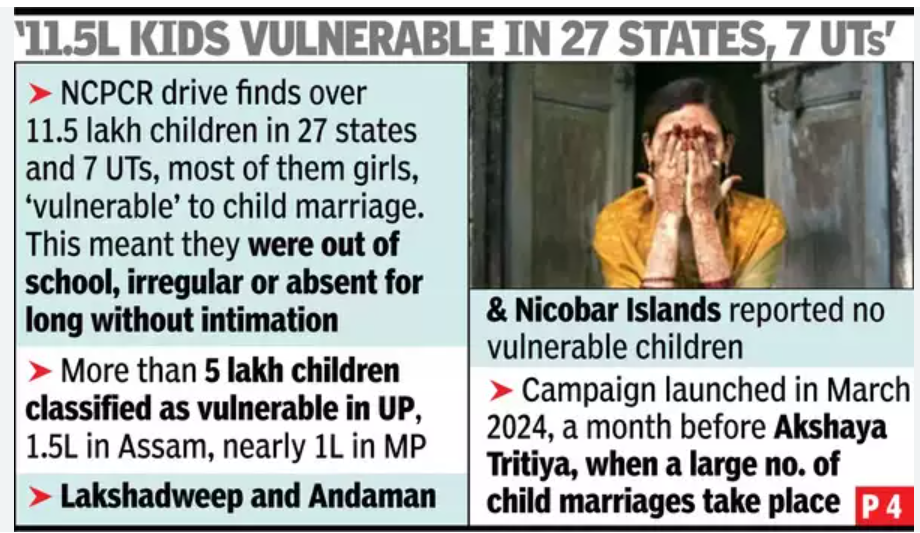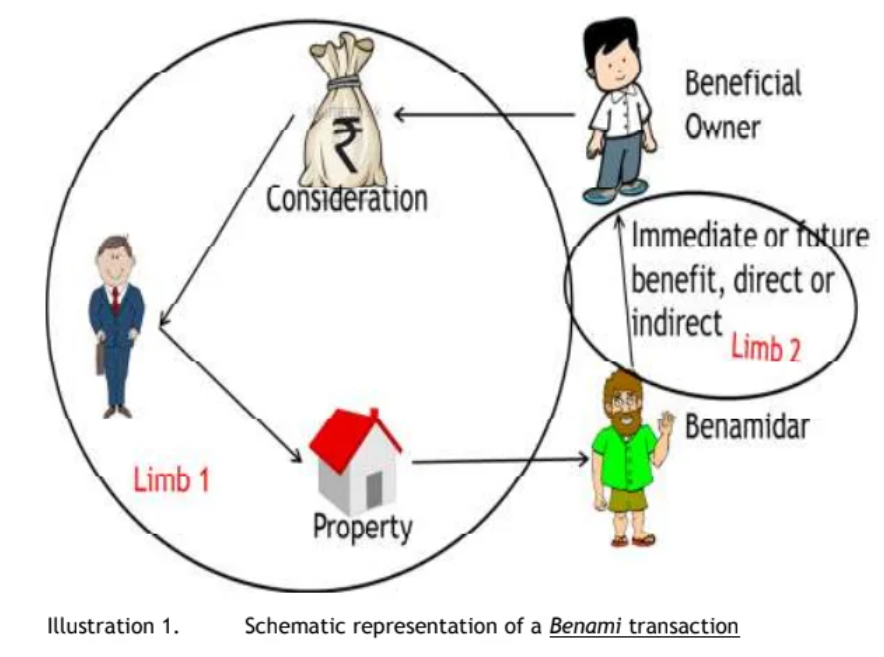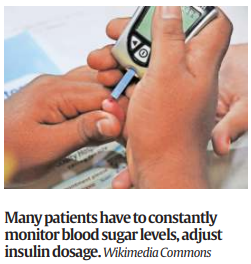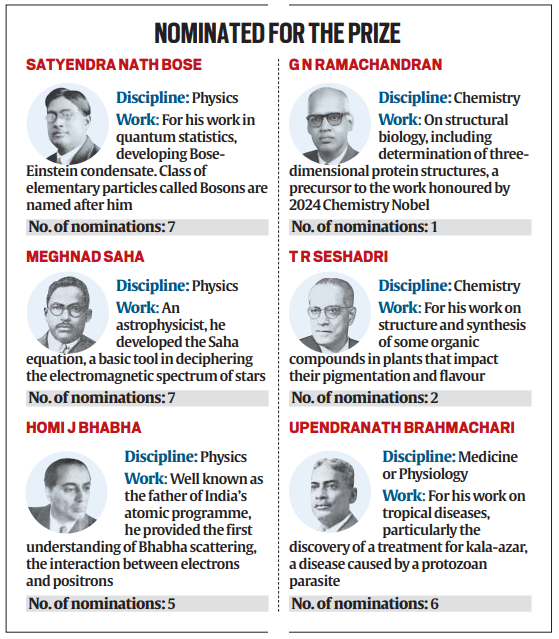19 October 2024 : Daily Current Affairs
1. Supreme Court Urges Parliament to Ban Child Betrothals, Calls for Comprehensive Measures to Combat Child Marriage
(Source: Indian Express; Section: Express Network; Page: 07)
| Topic: GS2 – Social Justice |
| Context: |
| The Supreme Court has urged Parliament to amend the Prohibition of Child Marriage Act to explicitly ban child betrothals, highlighting their violation of children’s rights and calling for comprehensive measures to prevent child marriages. |
Analysis of News:

The Prohibition of Child Marriage Act, 2006
- The law seeks to prevent child marriages by making certain actions punishable and by appointing certain authorities responsible for the prevention and prohibition of child marriages.
- Definitions under the Act
- “Child” means a person who, if a male, has not completed twenty-one years of age, and if a female, has not completed eighteen years of age.
- “Child marriage” means a marriage to which either of the contracting parties is a child.
- “Minor” means a person who has not attained his majority under the provisions of the Majority Act, 1875. As per the Majority Act, 1875, every person domiciled in India attain the age of majority on his completing the age of eighteen years.
- Child marriage is an offence punishable with rigorous imprisonment, which may extend to 2 years, or with fine up to Rs.1 Lakh, or both. The offences under the Act are cognisable and non-bailable.
- Persons who can be punished under the Law include
- Whoever performs, conducts or directs or abets any child marriage.
- A male adult above 18 years marrying a child (Section 9).
- Any person having charge of the child, including – parent or guardian, any member of an organisation or association, promoting, permitting, participating in a child marriage.
Supreme Court’s Stance on Child Betrothal
- The Supreme Court of India has urged Parliament to consider banning child betrothals by amending the Prohibition of Child Marriage Act (PCMA), 2006.
- The court highlighted that child marriages violate a minor’s right to free choice, autonomy, and childhood, stressing that betrothals in childhood deprive minors of their ability to make informed decisions about their life and partner.
|
Betrothal |
|
International Law and Child Marriage
- The court referenced international law, particularly the Convention on the Elimination of All Forms of Discrimination Against Women (CEDAW), which opposes child betrothals.
- It emphasized the need for targeted remedies to eliminate the practice, as child betrothals are often used to evade legal penalties under the PCMA.
Interface Between Personal Laws and PCMA
- The court addressed the conflict between personal laws and the PCMA. The Union Government had requested that the PCMA be given precedence over personal laws.
- The court noted that the Prohibition of Child Marriage (Amendment) Bill, 2021, seeks to clarify this and is currently under consideration in Parliament.
Social and Economic Impact of Child Marriages
- The Supreme Court highlighted the adverse effects of child marriages on both boys and girls.
- Early marriages deprive girls of their childhood and isolate them socially, while boys are burdened with adult responsibilities prematurely.
- Although the prevalence of child marriage in India has decreased since the enactment of the PCMA, gaps remain in implementing targeted measures for prevention.
Need for a Comprehensive Approach
- The court pointed out that existing government schemes, while impactful, are not sufficient to tackle child marriage comprehensively.
- A multifaceted approach, including training, awareness programs, and financial incentives, is essential.
- The court stressed that without direct economic support, families in financial hardship may still resort to early marriages, limiting the effectiveness of these programs.
| What are the Major Factors Associated with Child Marriage? |
|
Economic Factors:
Social Norms and Traditional Practices:
Gender Inequality and Discrimination:
|
| Practice Question: Critically analyze the legal, social, and economic implications of child marriages in India. How can amendments to the Prohibition of Child Marriage Act (PCMA) and targeted government measures help in effectively combating this issue? (250 words/15 m) |
2. Supreme Court Recalls 2022 Ruling on Benami Transactions Act, Restores Provisions for Fresh Adjudication
(Source: Indian Express; Section: Express Network; Page: 07)
| Context: |
|
Analysis of News:

About Benami Transactions (Prohibition) Act, 1988, act
- Definition of Benami Transaction: The Act defines a benami transaction as a transaction where a property is held by or transferred to one person, but the consideration for the property is provided by another person, and the property owner denies knowledge of ownership or the transaction involves a fictitious name.
Prohibition of Benami Property Transactions Act, 1988
- It is an Act of the Parliament of India that prohibits certain types of financial transactions.
- The act defines a ‘benami’ transaction as any transaction in which property is transferred to one person for consideration paid by another person.
- Such transactions were a feature of the Indian economy, usually relating to the purchase of property (real estate), and were thought to contribute to the Indian black money problem.
- The act bans all benami transactions and gives the government the right to recover property held benami without paying any compensation.
Benami Transactions (Prohibition) Amendment Act, 2016
- The Act seeks to deal with all such transactions which are carried out by a certain person but the consideration is provided and benefits are availed by some other person.
- A benami transaction, as defined under Section 2(9) of the Act is a transaction in which:
- The property is held by one person and paid for by another; or
- It is held in a fictitious name; or
- The owner of such property is unaware of or denies having knowledge of such ownership; or
- The person financing such a transaction is not traceable.
Reason for Review and Reversal
- A bench led by Chief Justice D.Y. Chandrachud, along with Justices J.B. Pardiwala and Manoj Misra, accepted the Solicitor General’s argument that the constitutional validity of the unamended 1988 Act was not under challenge in the first place.
- The court clarified that the original judgment had addressed an issue not contested by the parties, leading to its decision to allow the review petition and recall the previous judgment.
Restored Civil Appeals and Review Process
- The court restored the civil appeal for fresh adjudication and allowed all those affected by the 2022 judgment to seek a review of their respective orders.
- This opens the door for cases impacted by the 2022 decision to be reconsidered in light of the restored legal provisions.
Concerns Over the 2022 Judgment
- The August 2022 ruling had deemed Section 3(2) of the Benami Transactions Act, which prescribed jail terms for entering into benami transactions, unconstitutional.
- Additionally, it held that the 2016 amendments could only be applied prospectively, quashing all prosecutions or confiscations before the amendments took effect.
Concerns on PMLA Interpretation
- The court also raised concerns about a previous judgment upholding the Prevention of Money Laundering Act (PMLA), particularly regarding the potential for arbitrary application in property confiscations before trial.
- It hinted that further clarification is needed to prevent misuse of these provisions.
Context of the 2022 Ruling
- The 2022 judgment had emerged from the Centre’s appeal against a 2019 Calcutta High Court decision that found no provision allowing the retrospective application of the 2016 amendments to the Benami Transactions Act.
- With the review, the legal landscape for benami transactions and property confiscations now reopens for fresh adjudication.
|
PYQ: With reference to the ‘Prohibition of Benami Property Transactions Act, 1988 (PBPT Act)’, consider the following statements: (2017) 1) A property transaction is not treated as a benami transaction if the owner of the property is not aware of the transaction. 2) Properties held benami are liable for confiscation by the Government. 3) The Act provides for three authorities for investigations but does not provide for any appellate mechanism. Which of the statements given above is/are correct? (a) 1 only (b) 2 only (c) 1 and 3 only (d) 2 and 3 only Ans: (b) |
| Practice Question: Examine the implications of the Supreme Court’s decision to recall its 2022 ruling on the Benami Transactions (Prohibition) Act, 1988. What are the potential impacts on legal enforcement, property rights, and the broader framework for combating financial crimes in India? (250 words/15 m) |
3. House panel to discuss readiness to deal with ‘non-kinetic warfare’
(Source – The Hindu, International Edition – Page No. – 4)
| Topic: GS3 – Internal Security |
| Context |
| The Parliamentary Standing Committee on Defence will deliberate on the preparedness of the Indian armed forces for hybrid warfare, including cyber and non-kinetic threats. |
Non-Kinetic Warfare:
- Use of non-military means: Involves actions that are not directly violent, such as economic sanctions, diplomacy, and propaganda.
- Goal of achieving objectives without physical conflict: Seeks to influence behaviour or achieve political goals without resorting to armed force.
- Examples: US sanctions against Iran, international pressure on North Korea to denuclearize.
Hybrid Warfare:
- Blending of conventional and unconventional tactics: Combines traditional military force with cyberattacks, information warfare, and other non-military tools.
- Goal of destabilisation: Aims to erode an adversary’s capabilities and undermine their will to fight.
- Examples: Alleged interference of Russia in the 2016 US election, China’s use of economic leverage and propaganda.
| Practice Question: Discuss the concepts of hybrid warfare and non-kinetic warfare, highlighting their characteristics and real-world examples. How can states adapt to these evolving threats? (150 Words /10 marks) |
PRELIMS FACTS
1. Breakthrough in Smart Insulin Offers Hope for Millions with Diabetes
(Source: Indian Express; Section: Explained; Page: 12)
| Context: |
| Scientists have developed a glucose-sensitive “smart” insulin that automatically adjusts to blood sugar levels, offering a potential breakthrough in diabetes management. |
Analysis of News:

Prevalence and Impact of Diabetes
- Diabetes affects over half a billion people globally and causes around seven million deaths annually.
- The disease, characterized by elevated blood sugar levels, has seen a surge in prevalence worldwide.
- Managing diabetes requires constant monitoring of blood sugar and insulin levels, as improper regulation can lead to life-threatening complications.
Types of Diabetes and Current Treatment
There are two primary types of diabetes.
- In Type 1 diabetes, the pancreas produces little to no insulin, usually beginning in childhood.
- Type 2 diabetes involves the body’s cells becoming resistant to insulin, requiring higher levels than what the pancreas can produce.
- Both types are managed by synthetic insulin, but fluctuating blood glucose levels pose a challenge. Patients must frequently monitor and adjust their insulin doses, with overdosing potentially leading to dangerous drops in blood sugar.
Development of Smart Insulin
- Scientists have long sought to create glucose-sensitive insulin therapies. Current methods use sensors and insulin storage systems that release the hormone based on detected blood sugar levels.
- However, researchers from Denmark, the UK, Czechia, and the University of Bristol have made significant strides in developing smart insulin.
- This insulin, called NNC2215, includes an “on-and-off switch” that responds automatically to blood sugar fluctuations, eliminating the need for constant monitoring.
Mechanism of Smart Insulin
- NNC2215 consists of two components: a ring-shaped structure and a glucose-like molecule called a glucoside.
- When blood sugar is low, the glucoside binds to the ring, keeping the insulin inactive.
- As blood sugar rises, glucose replaces the glucoside, activating the insulin and lowering blood sugar levels.
- This innovation could significantly ease the burden of managing diabetes for millions.
Challenges and Future Development
- While NNC2215 has proven effective in animal trials, its activation is not gradual and requires a substantial glucose spike.
- Once activated, there is a sudden influx of insulin, which may not be ideal for gradual glucose management.
- Scientists are working on refining the molecule to ensure a smoother activation process and more controlled insulin release. Human trials are expected to follow soon.
2. India’s Struggle for Nobel Recognition in Science: Challenges and Contenders
(Source: Indian Express; Section: Explained; Page: 12)
| Context: |
| India’s limited success in Nobel Prizes for science highlights deeper issues in its research ecosystem and the global dominance of the US and Europe in scientific achievements. |
Analysis of News:
India’s Nobel Prize Record in Science
- Since the first Nobel Prizes in 1901, India has produced only one laureate in the sciences while working in India—Sir C.V. Raman, who won the 1930 Nobel Prize in Physics.
- Three other Indian-origin scientists—Har Gobind Khorana, Subrahmanyan Chandrasekhar, and Venkatraman Ramakrishnan—won Nobel Prizes while working outside India, none of them being Indian citizens at the time.
Challenges in Indian Science
- The lack of Nobel success reflects the broader issues in Indian science. Low public funding, inadequate attention to basic research, bureaucratic red tape, and limited private research incentives are stifling scientific potential.
- Indian institutions seldom engage in cutting-edge research, and the country has far fewer researchers per capita than the global average, shrinking the pool of potential laureates.
Indian Nobel Contenders

- Several Indian scientists have been nominated for the Nobel Prize, including Meghnad Saha, Satyendra Nath Bose, and Homi J. Bhabha, but none have won.
- Nominations are highly selective and confidential for 50 years, with data available only up to 1970.
- Many deserving Indian scientists, such as Jagadish Chandra Bose and K.S. Krishnan, were overlooked despite groundbreaking contributions.
Global Dominance of US and Europe
- Countries like the US and Europe have dominated the science Nobel Prizes, thanks to their robust research ecosystems.
- Asian, African, and Latin American countries have produced very few laureates.
- Even nations with strong scientific credentials, like China, Israel, and South Korea, have relatively few laureates, despite massive investments in research.
- India’s slow pace in building a scientific infrastructure means its future chances at Nobel success may largely depend on exceptional individual scientists.
Regional Disparities and Future Prospects
- While some claim regional bias in Nobel selections, the unparalleled research ecosystems of the US and Europe make them natural frontrunners.
- As countries like China strengthen their focus on cutting-edge technologies, they may see more laureates in the future.
- India, however, continues to lag behind in building its scientific capabilities, limiting its Nobel prospects.
3. Launch of Pilot projects in Steel Sector under the National Green Hydrogen Mission
(Source – https://pib.gov.in/PressReleseDetail.aspx?PRID=2065985®=3&lang=1 )
| Context |
|

National Green Hydrogen Mission Overview
- Approval Date: Union Cabinet approved on January 4, 2023.
- Budget: ₹ 19,744 crore allocated for the mission.
- Objective: To establish India as a global hub for green hydrogen production, usage, and export.
- Production Target: Aiming for the production of 5 million metric tons (MMT) of green hydrogen annually by 2030.
Key Components
- Demand Creation: Facilitate exports and domestic utilisation to boost demand for green hydrogen.
- SIGHT Programme: Strategic Interventions for Green Hydrogen Transition – providing incentives for electrolyser manufacturing and green hydrogen production.
- Infrastructure Development: Establishing Green Hydrogen Hubs to support production and distribution.
- Regulatory Framework: Developing robust regulations and standards for the green hydrogen industry.
- Research & Development: Promoting innovation through public-private partnerships.
- Skill Development: Training programs to prepare the workforce for green hydrogen technologies.
Economic Impact
- Investment Potential: Expected to attract over ₹ 8 lakh crore in investments by 2030.
- Job Creation: Estimated to generate 600,000 jobs.
- Import Reduction: Aims to cut ₹ 1 lakh crore in fossil fuel imports by 2030.
| Practice Question: Discuss the significance of the National Green Hydrogen Mission. Analyse its key components, expected economic impact, and the role of green hydrogen in India’s transition towards sustainable energy. (150 Words /10 marks) |
4. SC closes habeas corpus case against Isha Foundation
(Source – The Hindu, International Edition – Page No. – 3)
| Context |
|
Habeas Corpus: Concept
- Definition: Habeas corpus is a legal remedy enshrined under Article 32 and Article 226 of the Indian Constitution. It is a Latin term meaning “you may have the body.”
- Purpose: It protects individuals against unlawful detention by ensuring that the detained person is presented before the court to justify the detention’s legality.
- Constitutional Safeguard: Habeas corpus enforces fundamental rights such as the right to life and personal liberty under Article 21.
- Jurisdiction: The writ can be filed in both Supreme Court and High Courts.
| Constitutional Writs Under Article 32: |
|
Article 32 of the Indian Constitution empowers citizens to approach the courts for the enforcement of their fundamental rights. It includes five types of writs: Habeas Corpus: Ensures the release of a person unlawfully detained Mandamus: Commands a public official or body to perform a duty they are legally obligated to perform. Prohibition: Issued by higher courts to prevent lower courts from exceeding their jurisdiction. Certiorari: Directs a lower court or tribunal to transfer a case to a higher court or correct errors in its proceedings. Quo Warranto: Challenges the legal validity of a person holding a public office without proper qualifications. |
5. Ramanuja’s seven guidelines
(Source – The Hindu, International Edition – Page No. – 5)
| Context |
|
Teachings of Saint Ramanuja:
- Lord Narayana, along with His divine consort Mahalakshmi, is recognized as the Supreme Being beyond human comprehension and perception.
- Worshipping God can be easily performed in temples and at home, as His divine essence remains the same everywhere.
- All sentient and insentient beings are part of Lord Narayana’s divine body, promoting love and eliminating hatred among people.
- Devotees should focus their actions on pleasing God, acknowledging that they are merely instruments of His divine will and purpose.
- There are two primary paths to attain God: bhakti, which is devotion, and prapatti, which is surrender through an acharya.
- In Sri Vaikunta, all devotees experience divine ecstasy equally, with no discrimination among them, enjoying the bliss of God.
- Moksha, or liberation, can only be attained after leaving the earthly realm, leading to eternal union with the god.
| More About Saint Ramanuja |
|


